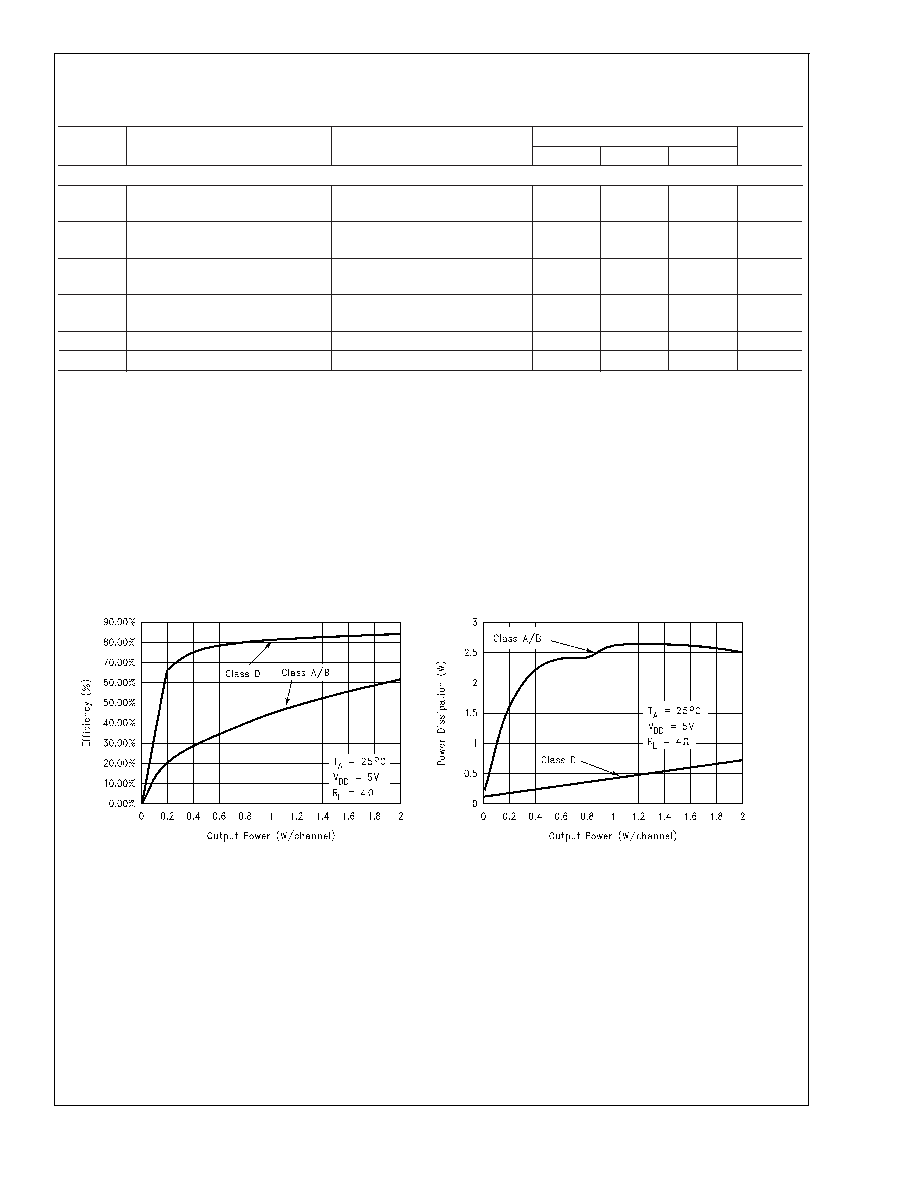- 您現(xiàn)在的位置:買賣IC網(wǎng) > PDF目錄30751 > LM4663MTX/NOPB (NATIONAL SEMICONDUCTOR CORP) 2.1 W, 2 CHANNEL, AUDIO AMPLIFIER, PDSO24 PDF資料下載
參數(shù)資料
| 型號: | LM4663MTX/NOPB |
| 廠商: | NATIONAL SEMICONDUCTOR CORP |
| 元件分類: | 音頻/視頻放大 |
| 英文描述: | 2.1 W, 2 CHANNEL, AUDIO AMPLIFIER, PDSO24 |
| 封裝: | TSSOP-24 |
| 文件頁數(shù): | 4/10頁 |
| 文件大小: | 605K |
| 代理商: | LM4663MTX/NOPB |

Electrical Characteristics (Notes 1, 2, 7) (Continued)
The following specifications apply for V
DD = 5V, RL =4, LC filter values as shown in Figure 1, unless otherwise specified.
Limits apply for T
A = 25C.
Symbol
Parameter
Conditions
LM4663
Units
Typical
Max
Min
Headphone Amplifiers
P
O
Power Out Per Channel
THD+N
≤ 1%, R
L =32,fIN =
1kHz
80
60
mW
THD+N
Distortion + Noise
P
O = 20mW, RL =32,fIN =
1kHz
0.15
%
V
NOISE
Output Noise Voltage, RMS
R
IN =50,CIN = 1F, BW =
8Hz to 22kHz
30
V
PSRR
Power Supply Rejection Ratio
(Referred to Input)
200mV, 1kHz, V
IN =0, RL =
32
44
dB
A
V
Voltage Gain
1kHz, V
IN = 100mV, RL =32
5.5
dB
A
VLAVR
Stereo Gain Tracking
1kHz, V
IN = 100mV, RL =32
0.1
dB
Note 1: All voltages are measured with respect to the ground pin, unless otherwise specified.
Note 2:
“Absolute Maximum Ratings” indicate limits beyond which damage to the device may occur. “Operating Ratings” indicate conditions for which the device is
functional, but do not guarantee specific performance limits.
“Electrical Characteristics” state DC and AC electrical specifications under particular test conditions which
guarantee specific performance limits. This assumes that the device is within the Operating Ratings. Specifications are not guaranteed for parameters where no limit
is given, however, the typical value is a good indication of device performance.
Note 3: For operating at case temperatures above 25C, the device must be derated based on a 150C maximum junction temperature and a thermal resistance of
θJA = 80C/W (junction to ambient).
Note 4: Human body model, 100 pF discharged through a 1.5 k
resistor.
Note 5: Machine Model 220pF240pF discharged through all pins.
Note 6: The operating junction temperature maximum is 150C.
Note 7: Limits are guaranteed to National’s AOQL (Average Outgoing Quality Level).
Typical Performace Characteristics
Efficiency vs Output Power
DS101269-10
Power Dissipation vs Output Power
DS101269-11
LM4663
www.national.com
3
相關(guān)PDF資料 |
PDF描述 |
|---|---|
| LM4664ITL/NOPB | 1.1 W, 1 CHANNEL, AUDIO AMPLIFIER, PBGA9 |
| LM4664ITLX/NOPB | 1.1 W, 1 CHANNEL, AUDIO AMPLIFIER, PBGA9 |
| LM4665MM/NOPB | 1 W, 1 CHANNEL, AUDIO AMPLIFIER, PDSO10 |
| LM4665MMX/NOPB | 1 W, 1 CHANNEL, AUDIO AMPLIFIER, PDSO10 |
| LM4665LD/NOPB | 1 W, 1 CHANNEL, AUDIO AMPLIFIER, DSO10 |
相關(guān)代理商/技術(shù)參數(shù) |
參數(shù)描述 |
|---|---|
| LM4664 | 制造商:NSC 制造商全稱:National Semiconductor 功能描述:Filterless High Efficiency 1.1W Switching Audio Amplifier |
| LM4664ITL | 制造商:Texas Instruments 功能描述:AMP FILTERLESS CLASS-A 1.1W 4664 |
| LM4665 | 制造商:NSC 制造商全稱:National Semiconductor 功能描述:Filterless High Efficiency 1W Switching Audio Amplifier |
| LM4665 WAF | 制造商:Texas Instruments 功能描述: |
| LM4665B WAF | 制造商:Texas Instruments 功能描述: |
發(fā)布緊急采購,3分鐘左右您將得到回復(fù)。